Would anyone still want to invest in the stock market if inflation did not exist?
The answer is a resounding YES! Even if inflation did not exist, the effects of compound interest make it well worth one’s time and effort to invest in the stock market. Let’s explore why this is the case. The following is an excerpt from my book Stock Market Investing for Newbies. If you would like to learn more about stock market investing but don’t know how to get started, why not pick up a copy of my book today?!?
What the heck is compound interest and what will it do for me?
Compound Interest and Stock Market Investing
Hold onto your hats here, because things may get a little rough – I promise not to make this too complicated. According to Wikipedia compound interest occurs when: “interest is added to the principal of a deposit, so that, from that moment on, the interest that has been added also earns interest.
I will have to admit, that is a little dry even for me, and I’m an engineer! OK – let’s see what I can do to clear things up.
One great way to help illustrate the principle of compound interest is with a neat little table (see Figure #1 below). Let’s say that you invest $100 dollars in a stock that increases in value exactly 5% every year for 10 years. It is clear that every year you will earn five dollars on the principal amount that you invested ($100).
But, there is something more that you will earn in addition to the five dollars interest. Notice the column in Figure #1 titled “annual interest earned on the interest”? Each year you are earning 5% interest not only on the $100, but also on the previous year’s interest that you have already been paid. So, in year number two, instead of just earning 5% interest on $100, you are earning 5% interest on $105!
Now, when you first get started investing, as in this example, that extra interest you’ll earn is small (only 25 cents for year two of this example). But, if you follow along in Figure #1 below, you will notice something interesting about the annual interest earned on the interest.
Figure #1 – Compound Interest Example – 10 years
The fun thing with compound interest (I know – I am a math geek at heart) is that the “annual interest earned on the interest” literally tend to explode as you get farther out in years! As a neat little exercise, here is what that same table looks like when taken out 50 years (see Figure #2).
Notice that the compound interest component of $49.61 is nearly 10 times the interest that one would earn from just the principal ($5)! I hope you see where I am going with this. If not, that is OK! We will look at compound interest in a different way.
Figure #2 – Compound Interest Example – 50 years
I hope you will see from Figure #2 above that compound interest really begins to take off when you get further out in time (number of years). The compound interest effect on your investments also increases at a much faster rate as you achieve a higher percentage return on your investment. In Figure #3 below, you will find a chart for the investor that purchased $100 of stock with various percentage annual returns.
Figure #3 – Illustration of Compound Interest
Notice that the higher the annual percentage return, the more quickly the compound interest effect becomes significant. The initial $100 investment can literally go to the moon if left to compound long enough. As promised, if all of these tables, graphs, and such are a little confusing, let’s look at a practical example that will reinforce the power of compound interest.
Let’s take two great people: Smart Sally and Dumb Derek (no relation to me, of course). Smart Sally can afford to invest only $400 a year into the stock market. Times are very tight for her, and she’s made great sacrifices to find this amount to invest into the stock market. We will assume that she selects a moderate asset allocation and she achieves a 7% annual return on her investments.
Dumb Derek decides that the stock market is not for him. He is able to convince himself that it is just too risky and only for “gamblers.” However, Dumb Derek is pretty good at saving. As a result, he is able to save a whopping $2,000 each year. What does he do with his savings? He takes the ultra-conservative approach and decides to stuff it under his mattress. For this example, we will assume there is no inflation – 0% inflation for the next 50 years.
Figure #4 – Compound Interest Example Smart Sally invests $400 a year at 7% interest; Dumb Derek saves $2,000 at 0% interest
Well, at the end of 50 years Dumb Derek has done pretty well for himself! He has been able to save a total of $100,000 ($2,000 a year times 50 years). Not too bad!
How about that Smart Sally? How can she expect to have much of a savings by only investing $400 a year into the stock market? At the end of 50 years, if she sells all of her investments, what would you guess she’s been able to put away total? If you guessed something in the ballpark of $173,994.38, then you would be right!
Would you look at that? Even though Smart Sally was only investing one fifth of what Dumb Derek was saving each year, her wealth has accumulated to more than 1.7 times Derek’s after 50 years! This is the awesome power of compound interest!
A neat rule of thumb that you can use to estimate the amount of time it will take your investments to double with compound interest is termed the rule of 72. You take the number 72 and divide it by the expected percent return. Thus, if we assume a 7% return from the stock market, you can expect your money to double roughly every 10 years (72/2 = 10.3 years). If you were able somehow to find investments that returned 10% annually, your money would double every 7.2 years (72/10 = 7.2). Pretty neat, huh?
One final thing I want to ensure you fully appreciate about compound interest is the tremendous power of time. Did you notice how it takes nearly 40 years for Smart Sally to catch up to Dumb Derek by investing only one fifth the amount that he does? However, after Smart Sally overtakes Dumb Derek, her savings begin to blow Dumb Derek’s out of the water. Because time is such a crucial component when it comes to compounding interest, you will hear me preaching over and over again that it is essential to begin your stock market investing journey just as early as you can.

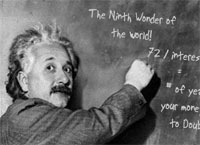
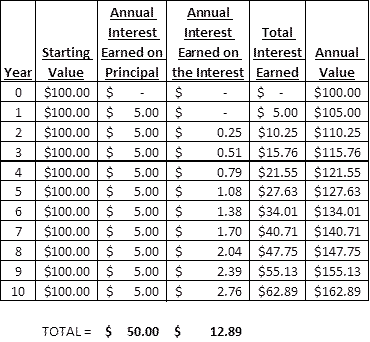
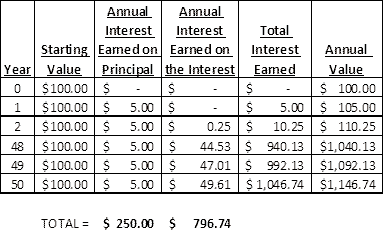
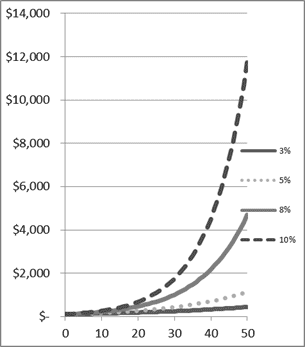
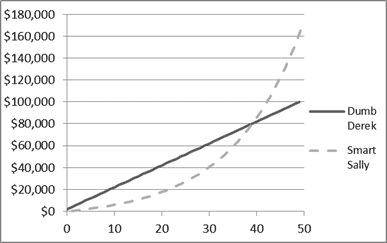


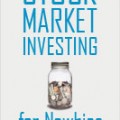




If they only taught kids one thing in financial literacy classes, it should be compound interest: why it is neglected is beyond me. Compound interest alone is sufficient reason to invest (to see the compounded returns) AND to stay out of debt or to pay it off quickly (to avoid compounded interest on the debt).
Myles Money recently posted…Free University Education For All
The simplest answer is usually correct – they don’t want you to know because then you won’t be a “worker” at their companies!
Great read!! I love seeing via charts exactly how awesome compound interest is. My husband and I have always had 401(k) plans but just recently started investing in mutual funds. Thanks for the post!!
Sarah recently posted…7 Things I won’t give up to save more money
Sarah,
Thanks for stopping by! Glad you liked the charts 🙂
I think the concept of compounding is lost on many people because for most of us the effects of interest and computing is very small initially. The best friend of compounding is time and that’s where the real magic of compounding comes into play. Great examples and nice charts too to illustrate what happens over time to an initial investment.
DivHut recently posted…November Stock Considerations
Thanks DivHut – I agree with you 100%. Most folks lose patience and never make it to the end points on those graphs!
I agree with DivHut above. Most people see that compounding is only earning them a few cents in the beginning. If they can learn to see the impact of compounding as their balances increases, it might motivate them to save more so they can take advantage of the increased speed of compounding sooner.
Jon @ Money Smart Guides recently posted…Finding The Right Online Broker For You
Jon,
I don’t think I fully appreciated how much compounding can really do for you until recently. It really is a pretty tough concept to get across to many of us!